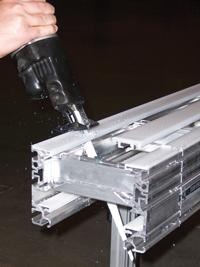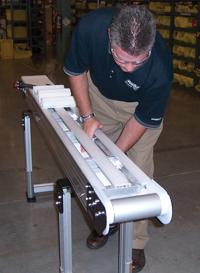- FMA
- The Fabricator
- FABTECH
- Canadian Metalworking
Categories
- Additive Manufacturing
- Aluminum Welding
- Arc Welding
- Assembly and Joining
- Automation and Robotics
- Bending and Forming
- Consumables
- Cutting and Weld Prep
- Electric Vehicles
- En Español
- Finishing
- Hydroforming
- Laser Cutting
- Laser Welding
- Machining
- Manufacturing Software
- Materials Handling
- Metals/Materials
- Oxyfuel Cutting
- Plasma Cutting
- Power Tools
- Punching and Other Holemaking
- Roll Forming
- Safety
- Sawing
- Shearing
- Shop Management
- Testing and Measuring
- Tube and Pipe Fabrication
- Tube and Pipe Production
- Waterjet Cutting
Industry Directory
Webcasts
Podcasts
FAB 40
Advertise
Subscribe
Account Login
Search
Extend conveyor life with maintenance, modification
Avoid line shutdown
- By Kim Stoll
- November 6, 2007
- Article
- Materials Handling
Forty years ago, conveyors were just expected to move items from point A to point B. They did that pretty well, but not much else.
To the naked eye, conveyor design doesn't look like it has progressed much since then. Looks can be deceiving.
The conveyors of today are engineered with unique design elements and innovations that make them more versatile than ever for metal stamping applications. But a conveyor with the latest technologies is good only if it is running properly. Simple preventive maintenance techniques can save you time, money, and a lot of headaches.
Innovations Add Versatility
Stamping applications in plants and facilities are constantly changing. Adding new equipment or producing new parts often requires reusing existing conveyors to support the new job requirements. Sometimes those existing conveyors fit the new application, but often that is not the case.
For example, if a new line calls for a conveyor
system to move large scrap metal from under a die to a bin 4 feet away, and the only conveyor available is 21/2 ft. long, that conveyor falls short. Or if a new line calls for a conveyor to turn 90 degrees to the left, an existing conveyor that turns only to the right misses the turn.
In the past you most likely would need to purchase a new conveyor each time you needed to make these types of changes. However, a new conveyor design allows you to quickly and easily lengthen or shorten the conveyor and change the angle of the corner to accommodate changing line requirements.
Being able to modify conveyor length not only saves the cost of purchasing a new one, it also saves time and prevents production delays while waiting weeks for a new conveyor to arrive. In addition, the hours spent locating and purchasing parts, designing the system, and physically building it quickly add up.
Many conveyors are designed to be modified in 10 minutes. To shorten a modular conveyor, you simply remove the belt, spindle, and support bracket (seeFigure 1). Then the belt can be cut to the desired length with a saw (see lead image). To lengthen it, you remove the belt and tail, attach a new segment and support bracket with a self-tapping screw slot assembly, reattach the belt and tail, and the conveyor is ready for operation.
Establish a Maintenance Program
Machinery such as punch presses needs to operate on a regular basis to be cost-effective. But if the supporting conveyor system is continually down for maintenance, that punch press will be offline too.
Even well-engineered conveyors that are built to operate around the clock need periodic maintenance to keep them up and running. One of the best ways for you to get a good handle on your inventory of conveyors is to create a preventive maintenance program. When managed effectively, it can catch potential problems before they shut down an entire line.
Consider how often the conveyors are operating each day. Obviously, the more hours a conveyor logs each day, the more frequently that conveyor will require an inspection.
Because conveyors often are on the move and used in multiple applications throughout a facility, it is best to identify each one with an asset tag as a way to track it. An up-to-date inventory list helps identify which conveyors are due for a maintenance inspection.
There is no right or wrong way to create an inventory database. Just make a system that works best for you.
Creating an inventory database doesn't require a complicated computer program. A simple Microsoft Excel® spreadsheet will suffice just fine. Key information to include in the database is conveyor make, model, and serial number; conveyor length and belt width; motor and belt type; date of last maintenance inspection and date of next inspection; type of maintenance performed; and the manufacturer's contact information.
Once the conveyors are inventoried and tagged, the next step is to establish a working bench stock of commonly used conveyor replacement parts. Belts and bearings are the most crucial replacement stock parts. To minimize potential downtime, keep at least one replacement belt and bearings in stock for each conveyor style used.
As far as performing maintenance and inspecting conveyors are concerned, the interval you establish is based on how often the conveyors are in use. If they are operating around the clock or two shifts a day, the maintenance interval probably should be once a month.
It is important to remember to lock out power to the conveyor and related equipment prior to removal for maintenance.
Nearly all conveyors can be disassembled and washed down with a light chemical cleaner and hot water to remove grease and oil. The conveyor belt surface should be inspected for cuts or wear, worn edges, stretching or breaking, and any lines or rough edges. Also, it should be inspected for stalling or slipping problems.
Over time lubricants and oils can cause the belt to stretch and weaken. Eventually a loose belt could cause the pulley simply to run over the belt if it is not on the conveyor properly. A nonmoving conveyor belt with parts and slugs piling up could damage the conveyor frame or the press. This may require belt replacement and could signify a larger problem with the conveyor itself.
About the Author
Kim Stoll
975 Cottonwood Ave.
Hartland, WI 53029
262-367-7600
Related Companies
subscribe now

The Fabricator is North America's leading magazine for the metal forming and fabricating industry. The magazine delivers the news, technical articles, and case histories that enable fabricators to do their jobs more efficiently. The Fabricator has served the industry since 1970.
start your free subscription- Stay connected from anywhere

Easily access valuable industry resources now with full access to the digital edition of The Fabricator.

Easily access valuable industry resources now with full access to the digital edition of The Welder.

Easily access valuable industry resources now with full access to the digital edition of The Tube and Pipe Journal.
- Podcasting
- Podcast:
- The Fabricator Podcast
- Published:
- 04/16/2024
- Running Time:
- 63:29
In this episode of The Fabricator Podcast, Caleb Chamberlain, co-founder and CEO of OSH Cut, discusses his company’s...
- Trending Articles
How to set a press brake backgauge manually

Capturing, recording equipment inspection data for FMEA

Tips for creating sheet metal tubes with perforations

Are two heads better than one in fiber laser cutting?

Hypertherm Associates implements Rapyuta Robotics AMRs in warehouse

- Industry Events
16th Annual Safety Conference
- April 30 - May 1, 2024
- Elgin,
Pipe and Tube Conference
- May 21 - 22, 2024
- Omaha, NE
World-Class Roll Forming Workshop
- June 5 - 6, 2024
- Louisville, KY
Advanced Laser Application Workshop
- June 25 - 27, 2024
- Novi, MI




























